16
AUG 2017
Determining Mitigation efforts in Wrongful Termination cases
Posted by Matt Rigling | Earnings, Employment, Job openings, Labor dataIn determining if a Plaintiff made extensive efforts in their job search following their alleged wrongful termination, economic experts should look into several key factors. Lawyer’s should be very familiar with these factors in order to best represent their client, whether Plaintiff or Defense.
- How many jobs has your client applied to and are they similar to the position they were terminated from? A major point of attack experts should address in their reports will examine if the Plaintiff has performed a sufficiently diligent replacement job search. In Texas, individuals are granted unemployment benefits provided they apply for a minimum of three jobs per week. This number can be used as the threshold for determining if a Plaintiff has done his or her due diligence in finding replacement employment after the alleged wrongful termination.
- How long has the Plaintiff been unemployed? Widely accepted labor market data from the U.S. Bureau of Labor Statistics can be utilized to determine the average range an individual with a similar job position, in the same job market, would expect to be unemployed. If the Plaintiff has been unable to find replacement employment within the typical unemployment duration, it is not likely they have performed a sufficient job search.
- How many job openings were available in the Plaintiff’s job market at the time of their termination? Again, data from the U.S. Bureau of Labor Statistics can be utilized to determine job openings per month that the Plaintiff would have been qualified to hold. In many cases, there are a significant number of job openings in the area the Plaintiff is searching. Occasionally, a Plaintiff’s job search records will reveal that they have applied to jobs in multiple job markets, sometimes spanning across several states. To a defense attorney requesting a mitigation analysis, this is music to their ears. The more markets a Plaintiff makes themselves available to, the more markets experts can include when determining a number of job openings. This only increases the number of jobs the Plaintiff could have held had they performed a sufficient job search and strengthens the argument that they have not performed such as search.



